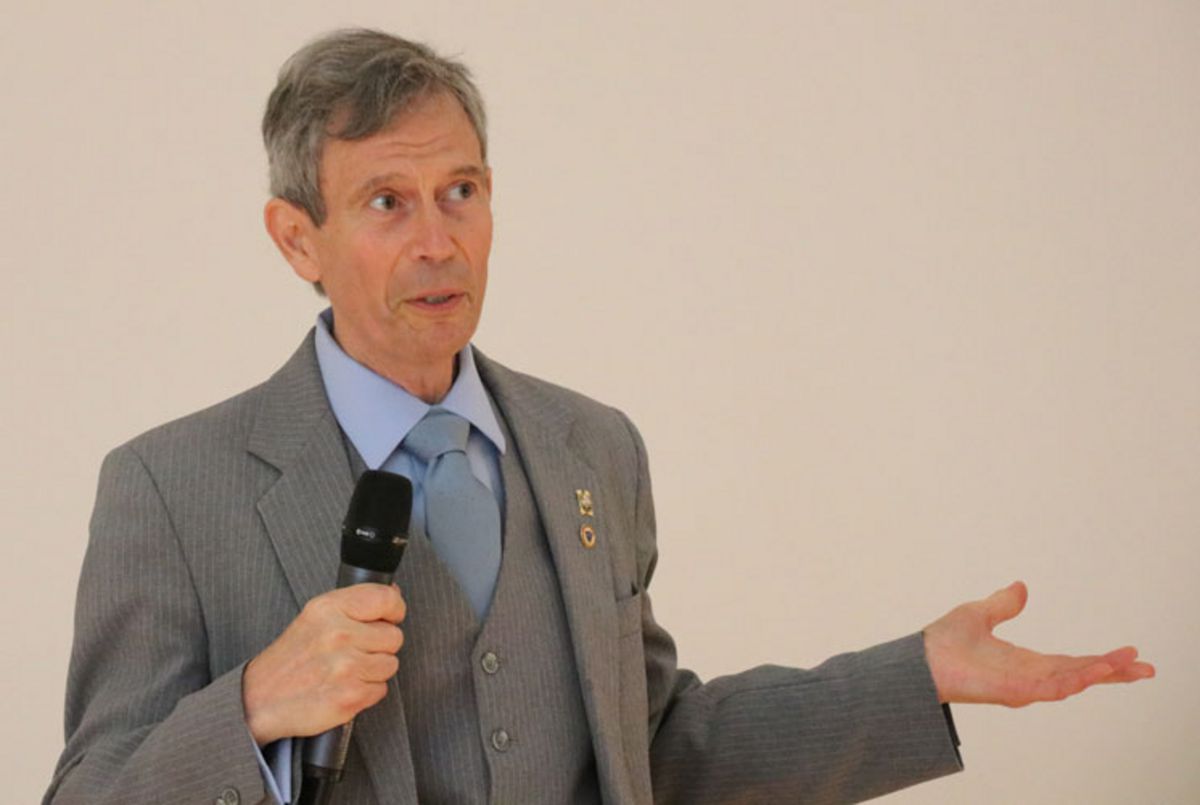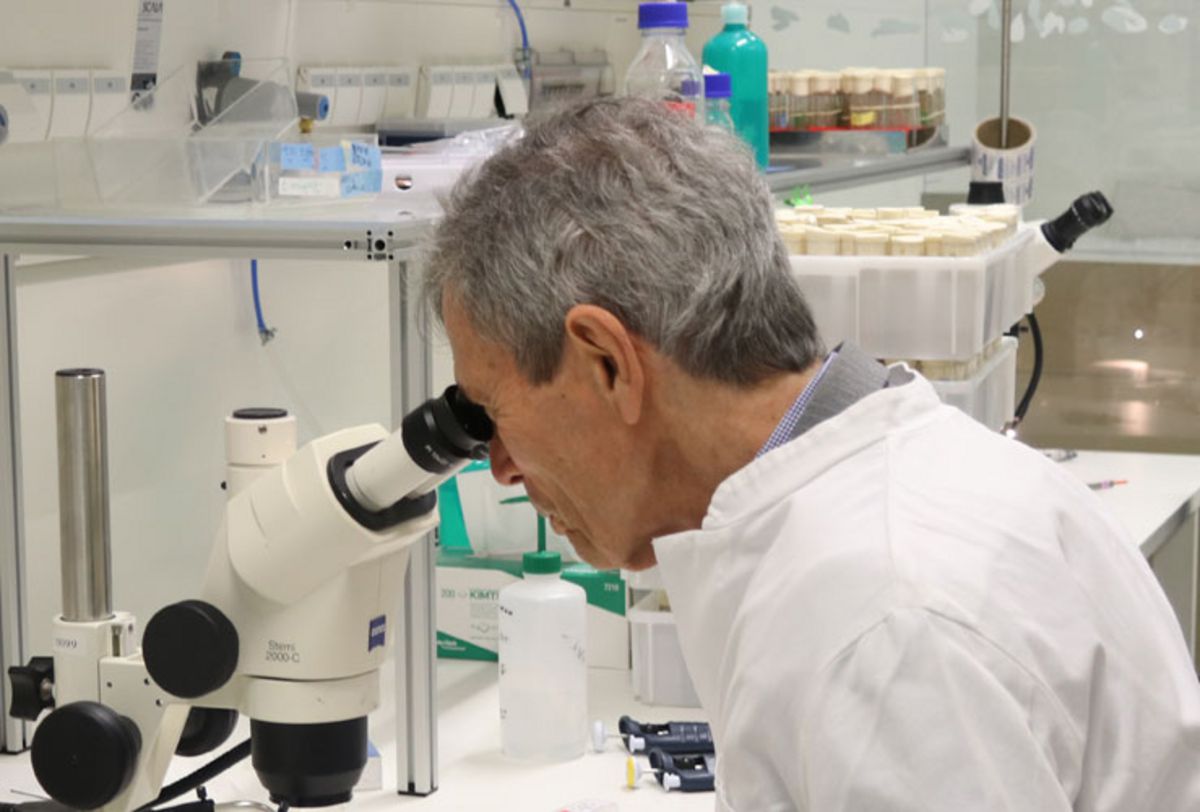Interview mit Jon D. Paul
Mr. Jon D. Paul, MSEE, is an American engineer, an inventor and entrepreneur. In 2008, he created the Paul Foundation in memory of his mother Blanche A. Paul. She bravely fought Parkinson’s disease for 25 years but ultimately succumbed to the disease. The Paul Foundation generously supports Prof. Donato (Dino) Di Monte’s laboratory at the DZNE in Bonn. Research carried out by Prof. Di Monte’s group focuses on molecular mechanisms of neuronal pathology in Parkinson’s disease and new therapeutic strategies against Parkinson’s disease.
The DZNE recently welcomed Mr. Paul in Bonn. He gave a very interesting talk titled: “The Amazing History of Our Digital Universe”. Mr. Paul is not only an engineer specialized in digital audio transmission, but also an expert in the history of espionage and cipher machines and an avid collector. For example, his interest in the French Revolution prompted him to collect original documents from that era. After his talk, the Board presented Mr. Paul with an acknowledgement plaque thanking him and his Foundation for supporting research at the DZNE. During his visit, Mr. Paul kindly sat with us for a brief interview.

Mr. Paul, how did you and Prof. Di Monte get to know each other?
Jon D. Paul: My mother suffered from Parkinson’s disease for many years and spent 13 years of her life in a nursing home in New York. I saw how much she suffered and learned about the side effects of Parkinson medications. Blanche Paul passed away in 2008 and I felt a need, an obligation to do something in her name. For this reason I started the Paul Foundation. Because she was a big fan of the arts, concerts, dance and museums, I thought I could do something to the benefit of the arts. And then the idea came: She suffered so much from Parkinson’s – it was such a horrible experience. I thought: What if I do something that would benefit other people suffering from this disease? I talked to a senior researcher at an institute in California and she said: “Mr. Paul, you really should get in touch with Dr. Dino Di Monte. He’s been doing exciting research on Parkinson for almost 20 years.” I think it was in 2008 or 2009. Dr. Di Monte worked near San Francisco at that time. I contacted him. We had a few phone calls and a few meetings in person. During one of these meetings, he mentioned to me the possibility that he may leave the USA and join a new research initiative in Germany. By creating the DZNE – he said - the German government had just made a bold commitment to foster research on neurodegenerative diseases. For any scientist, such commitment would represent a wonderful opportunity to work under the best possible conditions, state-of-the art infrastructure, highly interactive environment and longer-term perspectives that encourage high risk (high reward) research. I also thought that it would make sense for me to contribute to this exciting research initiative. Retrospectively, I did make the right decision. Eventually, I also met Dr. Di Monte’s wife, Dr. Sarah Jewell. She is the Head of Scientific Strategy at the DZNE. After several conversations with her, two things really impressed me about funding research at the DZNE. First, the financial support would go directly into research, without major bureaucratic interface or major administrative costs. Secondly, I would have the opportunity to be directly engaged with people doing research with my Foundation’s support. I said to Sarah: “I wouldn’t like to just provide financial support to an institution. I would really enjoy having direct personal contact with the researchers. I’m an engineer, I know nothing about medicine. But I’m interested in technology, I’m interested in people and I like to discuss about the overall experimental process: what is the rationale for a scientific hypothesis? Did the experimental outcomes support the original idea? If not, how to move forward bypassing possible obstacles?” The responses I had were perfect for me. So this is how my commitment with the DZNE started.
Since when do you support projects through donations?
Jon D. Paul: I think the first official commitment was in 2010. So it is now seven years. Initially, I thought: How much can I afford? I discussed with Dr. Di Monte (Dino) about different options to support a high-risk research projects for a year and identified a financial option that I could afford. We started with the first project. After the first year, I was very pleased with the work in Dino’s laboratory. His research team tackles critical issues concerning the development of Parkinson’s disease, and their results are published in widely read scientific journals. I thought to myself “This is exactly what the Paul Foundation was intended to do”. Since then, my support has continued year after year, and will continue in years to come. Every year, Dino and his group propose a new project and interesting new ideas. At the same time, they show me very technical papers – I often cannot even understand their titles…. I print the paper out, read it and get to the part where it says: “Acknowledgements: Funding provided by Paul Foundation”. It makes me feel I have accomplished something with my support.
![[Translate to Englisch:] Gruppenfoto [Translate to Englisch:] Gruppenfoto](/fileadmin/Dateien/editors/images/Webnews/2017/Don_D.Paul/csm_IMG_3299_web_2996e6f47d.png)
Is it important for you to have a relationship with the projects and people you support?
Jon D. Paul: Absolutely! I like to see how science advances and to think - that paper and this piece of research- I helped to fund it! It is also important for me that, over the years, Dino, Sarah and I have become good friends. We meet regularly when I travel to Europe, and they have visited me in California several times.
You have supported other kinds of projects/activities. Please tell us something about them.
Jon D. Paul: For a few years in the past, the Paul Foundation provided a scholarship for a career-bound ballet dance student. The reason was that my mom loved opera, theater and ballet in New York. Most recently, however, the Foundation has focused on funding Parkinson’s disease research and, for this reason, my connection with the DZNE became stronger and stronger.

Which advice do you have for scientists / scientific institutions to communicate research progress?
Jon D. Paul: I think that publishing papers in high-impact journals is very important. But it is also important to reach the general public. The DZNE does a good job on its website where important research updates are presented. I think a lot of scientists (just like us engineers) are kind of reserved people very focused on what they do. It is important however that, no matter at what institution they work, scientists should be encouraged to contact their press offices if they have new results. The press office can then inform the media about research breakthroughs that would interest general people and, in particular, patients.
How would you (or how should anyone) foster further support for research?
I think the significance of what is being done in the scientific world has to be better communicated and understood. The continuous progress in basic research like the one done here at the DZNE opens exciting future possibilities. Maybe we will not cure Parkinson tomorrow but with the advancement of medicine and science we will ultimately find solutions to this and other diseases. I know a lot of people who want to see immediate results. Typically, the reaction that I get when I tell somebody that I support research on Parkinson’s disease is: “my aunt, my grandfather or a friend of mine suffered of this disease. Is there any cure for it or a way to detect it earlier or a better medication?” I am asked if I know of any new drug that would immediately stop the disease and eliminate the awful symptoms affecting their relative or friend. I do understand this urgency. On the other hand, I also appreciate the importance of supporting very basic research and the fact that research is unpredictable: it may produce breakthroughs right away or it may take years for basic research results to help solving medical problems. A reason for optimism is the availability of more and more sophisticated technologies that are speeding up the pace of research. I also believe in the transfer of ideas, technology and discoveries from one scientific field to the other. People should always be thinking: “Maybe this idea, this invention in my field could be applied to something completely different.” For example, I just met with Prof. Nicotera, the DZNE’s Scientific Director, and he mentioned a new collaborative initiative between the DZNE and the Hewlett Packard Enterprise. Through this initiative involving memory-driven computing, analysis of big data in research and medicine could be tremendously facilitated and accelerated. As an engineer, I find this quite feasible and very exciting.
Interview: DZNE/Christine Knust, images: DZNE
